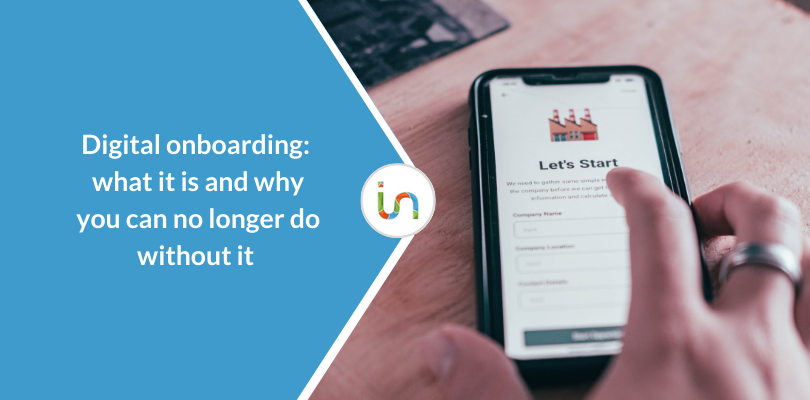
Digital onboarding: What it is and why you can no longer do without it
The first days of work for a person can be as full of emotions, linked to the novelty, the desire to do and to leave a mark, as they can be terrible and therefore unforgettable.
In fact, the moment when a new employee or associate enters a structured reality is anything but “easy”: he/she does not know anyone or almost anyone, he/she is not yet aware of the company culture, even if he/she has studied the website and social networks to the letter, and has already passed all the previous interviews. This is therefore an extremely delicate phase for those working in the HR world. A phase that is perfectly summarized by an English word: onboarding.
But what are we talking about when we talk about onboarding? And what are the characteristics, instead, of digital onboarding? And why, after the pandemic, can’t we do without it anymore?
Let’s try to find out starting from the definition.
Onboarding: definition and types

First of all, let’s try to understand what onboarding is, trying to give a definition. Onboarding is the moment when a person “comes on board”, i.e. the official beginning of the relationship between the company and the employee or associate. This is a delicate moment because, as we know, the search and selection process certainly does not end with the signing of the contract and the hiring, but continues with the two entities beginning to get to know each other and to understand if they have made the right choice.
We could therefore say that it is the normal insertion of a worker into the company, but onboarding is actually much more than that.
Ideally, it follows the phases of attraction and evaluation of the candidate, but it is also true that it is at this moment that the newly hired person should acquire all the knowledge necessary to become an integral part of the company, both in terms of the rundown of the organization and the values that distinguish it, the promise of value, how it works and so on.
That’s why, at such a stage, a person must be guided and not left to his or her own devices.
Moreover, according to Peakon‘s data, which analyzed employee feedback from more than 1,000 companies in 160 countries, onboarding lasts a maximum of 3 months.
This is a period of time in which people are very uncertain about their surroundings and which leads them to immediately want to establish their place within the organization, to want to make a meaningful contribution and to start building relationships with colleagues.
So this is a key step in building trust with newly hired people and making them feel involved from the start. Also because it seems that 30% of job seekers actually leave within 90 days of finding a job.
In addition to the world of HR, it’s good to know that we talk about onboarding also in terms of customer acquisition: in this case, too, we’re talking about the beginning of a direct relationship between an individual who is a registered user or an almost-customer who will have to decide whether or not to become one by purchasing services and products.
What is digital onboarding
Back in the world of work, thanks to a pandemic that has forced us all home, digital onboarding has taken on an increasingly important role. And that adjective, digital, has become the key to everything.
It means that the onboarding process is available online, which allows HR to communicate with the newly hired person immediately and without wasting too much time from day one.
If you think about it, beyond the need dictated by social distancing, digital onboarding can be the solution to manage this period, which as we mentioned can last up to 3 months. That is, it allows you to do it in a more distributed fashion, avoiding HR team overload and providing new employees with a training process that is not only longer, but also more personalized. Think, then, of all those who will be working in smart working mode: with digital onboarding, you go even further to meet their needs and avoid leaving them on their own.
Also because digital onboarding, through online platforms, gives new hires 24/7 access to the information they need: company policies, work tools, organization chart, documents, courses, etc…
This is advantageous both for those who may have to work at night or early in the morning and, in general, to ensure that new hires quickly and effectively find the information they are missing and avoid, instead, hearing the information they have already acquired.
During the first few days, new hires are bombarded with information; with digital onboarding, they can be the ones to better manage the process of acquiring notions and joining the company.
How to welcome new employees into the company in the days of covid-19

So far so clear, but how in fact to welcome new employees in the days of Covid-19 and use digital onboarding to its fullest? There are several ways, and it obviously depends on your goals.
Analyze the onboarding process and figure out how to improve it
The first advice we can give you is to analyze the current onboarding process and understand how to improve it. How to do this in practice? You could ask for feedback both from those who have already concluded the onboarding phase and from those who are living it. In this way, you can identify problems and weaknesses.
To make sure people feel free to respond, you might conduct anonymous surveys. Otherwise, be clear about why you are asking for this information. In fact, if you explain that this way new hires can already make a contribution to the life of the company, we are sure they will have no problem contributing, even with their first and last name.
Automate and simplify onboarding with an ATS
In times like we’re experiencing, this phase needs to be as streamlined but also as stress-free as possible. That’s why if you automate this process, including tailoring it to the different characteristics of new hires, onboarding will really help them understand what they need to “feel onboarded.”
Also because new employees aren’t all the same: someone entering an internship, for example, is probably fresh out of college and has no corporate experience, while someone who is senior will have several years behind them so they may only need a certain type of information and not others. In addition, by organizing virtual meetings, which you can also do with ATS software such as In-recruiting, you can better understand the various needs and respond in a timely manner.
The integration between an ATS and HR software for onboarding, however, allows you to follow the entire recruiting phase, from the moment when the need to find new candidates arises until they are selected, hired and begin to enter into contact with the company.
Specific HR software allows, for example, to set up training plans to strengthen the skills of those who have been hired, acquire new ones and do so in an interactive and collaborative manner. Often new hires find themselves alone in the onboarding phase, while thanks to company social networks, forums and chats they have the opportunity to compare themselves with others who are on the same path, but also with those who have already done so.
Without forgetting, then, that integration between the different systems has a huge advantage. That is, it allows for the automatic passage of candidate data from the recruiting platform to the onboarding platform and within the Human Resources Management software chosen by the company (HRMS).
All of this, it must be said, translates into considerable time savings and greater efficiency: a “holistic approach” is thus followed that meets the needs of the candidate who immediately feels “inserted” in the company context.
Show new hires how far they can go

That this process is necessary is something all employees know, but it shows in a practical and concrete way what results they can achieve. How? With charts and statistics that show new hires how their work can impact the growth of the organization, the skills they can acquire, and so on.
Connected to this, it’s important for people to understand what career path they’ll be able to take, but also how long it takes to complete their tasks and so on. It is important, then, to make several checks to see if everything is going as planned and how new hires are facing the tasks at hand.
Assign a mentor
Mentorship is increasingly being talked about, and this is even more true in the onboarding phase. If a new hire is being mentored by someone who is willing, this is definitely a plus. The mentor will be responsible for not only sharing the information they have, getting to know the company and their colleagues, but also understanding how the newcomer feels about all of this and the tasks assigned to them.
The main benefits of digital onboarding
That said, what are the main benefits of digital onboarding?
There are several, here they are listed:
- avoid lengthy meetings and handing out paperwork, both the environment and the new hire will thank you;
- quickly update new hires on the history of the organization, the vision of the company and its values, and you do so without time and time constraints, meeting their needs;
- employ fewer people, which means you reduce the costs of individual or classroom training. And, as we mentioned earlier, this way the onboarding phase is personalized and involves employees even more;
- get ahead of the curve by starting on day 0 but also before the new hire sets foot in the company;
- make the onboarding easy also for those who will work constantly in smart working and also for those who are not hired;
- keep track of how the process is going, what tools and documents new hires are making use of so you can constantly adjust. And this is certainly possible with ATS software that not only allows you to use the data at your disposal, but to take notes that you can use later. All within a single platform where you’ve already managed the other phases of recruiting;
- guarantee that nothing is lost because everything is digitally “stored”;
- provide reference materials that employees can use in the future.
Digital onboarding and artificial intelligence

Artificial Intelligence can also play an important role in digital onboarding, allowing, as we mentioned, to design and customize the various digital modules based on user behavior.
If a person at that moment is “studying” some documents, thanks to AI he can have suggestions that allow him to complete that path, for example. Just as, if some skills and information that the person already has emerged in the CV of the new hire, with digital onboarding and AI, it avoids going back to certain topics and makes the whole process less monotonous. As well as more effective.
In the Covid era, then, Artificial Intelligence-based interviews can be particularly useful, allowing recruiters to reach out to a higher number of candidates and find those best suited for their positions.
Automation can also be beneficial when the new hire has doubts, and in that case thanks to a chatbot they can have the most urgent answers at all hours. This will help the person feel “taken care of” and considered. If he then needs more information, he can always turn to the recruiter or mentor.
These of course are just a few examples of how digital onboarding and AI can help improve a phase of recruitment that is not only crucial for the employee, but for the entire company.
A person leaving a few months after being hired means starting all over again, wasting even more resources, and most importantly, it can contribute to a company’s deteriorating reputation. That’s why even onboarding, though it may not seem like it, is closely tied to recruiting marketing.
Request a demo of In-recruiting

Giornalista, content strategist e formatrice
Siciliana trapiantata a Milano, città che ama molto come la sua terra. Giornalista, SEO copywriter, formatrice e amante del live tweeting, scrive per varie testate e blog aziendali di lavoro, risorse umane e tanto altro.
Ha scritto nel 2020 il suo primo libro “Scrivere per informare” insieme a Riccardo Esposito, edito da Flacowski e nel 2021 altri due: “L’impresa come media” e “Content marketing per eventi“.
Ama il mare, la bici, la pizza, i libri, le chiacchiere all’aperto.